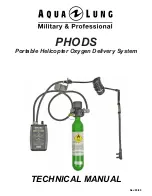
Appendix
— Reference Guide
Appendix–
27
Compander
A compander is a compressor-expander—a combination of signal compres-
sion and expansion. The compander attenuates the input signal above the
threshold as well as the level below the width. For very dynamic material,
this program allows you to retain the dynamic range without having to be
concerned with excessive output signal levels and clipping.
CompanderH (CPH) and CompanderS (CPS) parameters:
Threshold
determines the level of input signal required to trigger the com-
pander. Signals above the threshold pass through unaffected. Signals at and
below the threshold level are attenuated by the amount specified using the
Ratio parameter. The trigger signal is determined using the KEY IN parame-
ter.
Ratio
controls the amount of companding—the change in output signal
level relative to change in input signal level. With a 2:1 ratio, for example, a
10 dB change in input level (above the threshold) results in a 5 dB change
in output level. The hard compander (CPH) has a fixed ratio of 5:1 for
expansion and the soft compander (CPS) has a fixed ratio of 1.5:1 for
expansion.
Attack
controls how soon the signal is companded once the compander has
been triggered. With a fast attack time, the signal is companded almost
immediately. With a slow attack time, the initial transient of a sound passes
through unaffected.
Out Gain
sets the compander’s output signal level.
Width
is used to determine the distance, in decibels, between the expander
and the compressor. With a width of 90 dB, the expander is effectively
switched off and the compander is simply a compressor-limiter. With a
smaller width (30dB) and a high threshold (0dB), the compander is an
expander-compressor-limiter.
Release
determines how soon the compander returns to its normal gain
once the trigger signal level drops below the threshold.
Parameter
Value
Threshold (dB)
–54 to 0
(55 points)
Ratio
1.0, 1.1, 1.3, 1.5, 1.7, 2.0, 2.5, 3.0, 3.5, 4.0, 5.0, 6.0, 8.0,
10, 20
(15 points)
Attack (ms)
0 to 120
(121 points)
Outgain (dB)
–18 to 0
(36 points)
Width (dB)
1 to 90
(90 points)
Release (ms)
5 ms to 42.3 sec
*1
, 6 ms to 46.0 sec
*2
,
8 ms to 63.4 sec
*3
(160 points)
*1. These values are obtained when the sampling frequency is 48kHz.
*2. These values are obtained when the sampling frequency is 44.1 kHz.
*3. These values are obtained when the sampling frequency is 32 kHz
-70
-60
-50
-40
-30
-20
-10
0
+10
+20
-70
-60
-50
-40
-30
-20
-10
0
+10
+20
Input Level
Output Level
dB
dB
Threshold
Width
Содержание AW4416
Страница 1: ......
Страница 2: ...PROFESSIONAL AUDIO WORKSTATION E Operation Guide ...
Страница 87: ...Chapter4 Connections and setup 72 Operation Guide ...
Страница 123: ...Chapter5 Recording on the AW4416 108 Operation Guide ...
Страница 161: ...Chapter8 Patching 146 Operation Guide ...
Страница 179: ...Chapter9 Track and virtual track operations 164 Operation Guide ...
Страница 282: ...PROFESSIONAL AUDIO WORKSTATION E Reference Guide ...
Страница 473: ...PROFESSIONAL AUDIO WORKSTATION E Tutorial ...
Страница 477: ...Tutorial AW4416 Professional Audio Workstation 4 Tutorial ...
















































